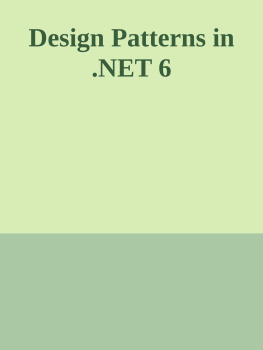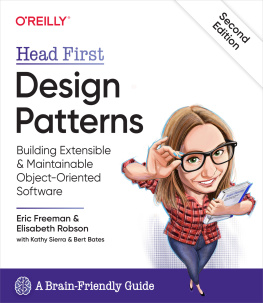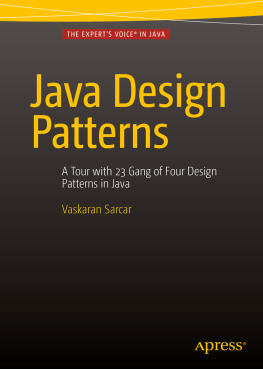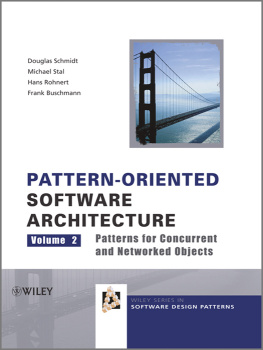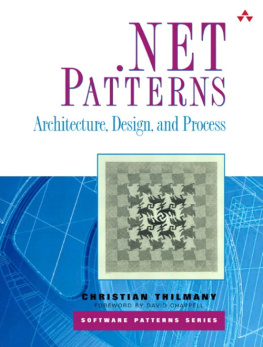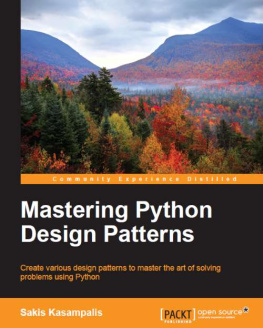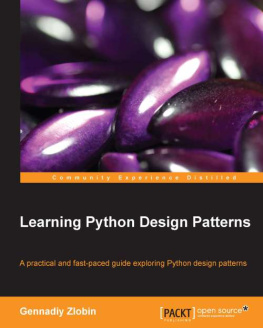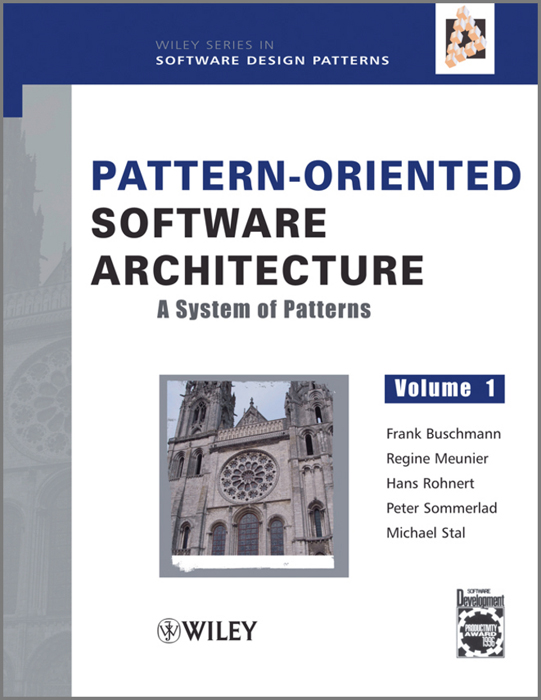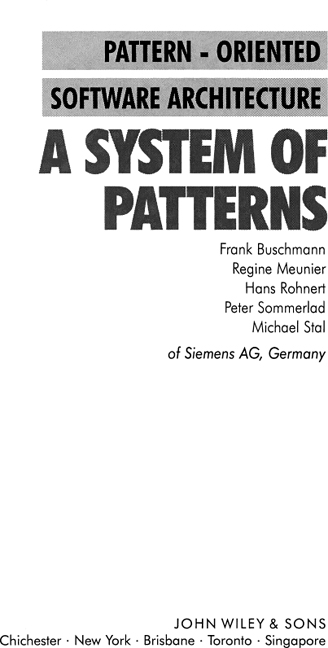PATTERN - ORIENTED SOFTWARE ARCHITECTURE
A SYSTEM OF PATTERNS
Other titles in the Wiley Series in SOFTWARE DESIGN PATTERNS
PATTERN-ORIENTED SOFTWARE ARCHITECTURE
VOLUME 2: Patterns for Concurrent and Networked Objects
Douglas Schmidt, Michael Stal, Hans Rohnert, Frank Buschmann
Designing application and middleware software to run in concurrent and networked environments is a significant challenge to software developers. This book presents 17 interrelated patterns ranging from idioms through architectural designs. They cover core elements of building concurrent and network systems: service access and configuration, event handling, synchronization, and concurrency. All patterns present extensive examples and known uses in multiple programming languages, including extensive examples and known uses in multiple programming languages, including C++, C and Java.
0 471 60695 2 cloth 634pp 2000
A PATTERN APPROACH TO INTERACTION DESIGN
Jan Borchers
Discover the power of the pattern format in user interface design. Key features of this book include a comprehensive pattern language for the interface design of interactive exhibits as well as a thorough introduction to original pattern work and its application in software development.
This book offers invaluable practical guidance for interface designers, project managers and researchers working in HCI, as well as for designers of interactive systems.
0 471 49828 9 cloth 250pp 2001
Copyright 1996 John Wiley & Sons Ltd,
The Atrium, Southern Gate, Chichester,
West Sussex PO19 8SQ, England
Telephone (+44) 1243 779777
Email (for orders and customer service enquiries):
Visit our Home Page on www.wileyeurope.com or www.wiley.com
Reprinted October 1996, July 1997, July 1998, April 1999, June 2000, February 2001, July 2001, November 2002, August 2004, September 2005, February 2006, April 2007, January 2008, March 2008, January 2009
All Rights Reserved. No part of this publication may be reproduced, stored in a retrieval system or transmitted in any form or by any means, electronic, mechanical, photocopying, recording, scanning or otherwise, except under the terms of the Copyright, Designs and Patents Act 1988 or under the terms of a licence issued by the Copyright Licensing Agency Ltd, 90 Tottenham Court Road, London W1T 4LP, UK, without the permission in writing of the Publisher. Requests to the Publisher should be addressed to the Permissions Department, John Wiley & Sons Ltd, The Atrium, Southern Gate, Chichester, West Sussex PO19 8SQ, England, or emailed to , or faxed to (+44) 1243 770571.
This publication is designed to provide accurate and authoritative information in regard to the subject matter covered. It is sold on the understanding that the Publisher is not engaged in rendering professional services. If professional advice or other expert assistance is required, the services of a competent professional should be sought.
Other Wiley Editorial Offices
John Wiley & Sons Inc., 111 River Street, Hoboken, NJ 07030, USA
Jossey-Bass, 989 Market Street, San Francisco, CA 94103-1741, USA
Wiley-VCH Verlag GmbH, Boschstr. 12, D-69469 Weinheim, Germany
John Wiley & Sons Australia Ltd, 33 Park Road, Milton, Queensland 4064, Australia
John Wiley & Sons (Asia) Pte Ltd, 2 Clementi Loop #02-01, Jin Xing Distripark, Singapore 129809
John Wiley & Sons Canada Ltd, 22 Worcester Road, Etobicoke, Ontario, Canada M9W 1L1
Cover illustration: Based upon a photograph of Chartres Cathedral.
Monique Jacot / Network photographers Ltd.
British Library Cataloguing in Publication Data
A catalogue record for this book is available from the British Library
ISBN 13: 978-0-471-95869-7 (H/B)
For Martina
Frank Buschmann
For Michael, Anja and Sandro
Regine Meunier
For Ute
Hans Rohnert
For Andrea
Peter Sommerlad
For Gisela, Macho, Merlin
Michael Stal
About this Book
This is a book about patterns for software architecture, or simply, patterns. Patterns have been drawing considerable attention over recent years: workshops, tutorials, forums for electronic discussion, papers in journals and whole books are being devoted to patterns. The pattern community has even started its own conference. All this enthusiastic discussion of patterns makes them seem as if they are the climax of the object wave.
What is so exciting about patterns? It is probably the fact that they constitute a grass roots effort to build on the collective experience of skilled designers and software engineers. Such experts already have solutions to many recurring design problems. Patterns capture these proven solutions in an easily-available and, hopefully, well-written form.
We want this book to support both novices and experts in software development. It should help novices to act as if they wereor almost as if they wereexperts on modest-sized projects, without having to gain many years of experience. It should support experts in the design of large-scale and complex software systems with defined properties. It should also enable them to learn from the experience of other experts. The book should help both groups to find well-proven solutions, as well as alternatives, to specific design problems.
The book is intended to be both an instructive text and a reference guide. It helps software developers to think about software architecture in a new way, and presents a number of techniques for solving particular recurring design problems. Using this book as a guide in a software engineering course can provide students with an entirely new perspective on the design of large-scale software systems. It can serve as a reference manual, because it presents our techniques comprehensively and ready for use. We include many guidelines and constraints for the practical application of the patterns we include.
The idea of recording design wisdom in a canonical form can be traced to Christopher Alexander. He pioneered patterns in the context of the architecture of buildings. His book The Timeless Way of Building shows how patterns can be applied to house construction, as well as to the planning of neighborhoods and whole cities. The underlying theme of his work is the design of living places that are not only functional and fashionable, but also comforting and consoling. Well-designed buildings demonstrate inherent qualities that can be clearly perceived, but are hard to describe or quantify. In short, such buildings possess a quality without a name.
Early experiments in adapting this approach to software engineering leaned heavily on Alexanders style. More recently the software community has been experimenting to find a stylistic form better-suited to software design. Several different description forms for patterns have been tried, but there is no consensus yet.
Although we put considerable effort into finding a good way to describe patterns, developing theories on pattern styles is not the main goal of this book. It was certainly not our initial motivation for starting work on patterns. In 1991 we recorded our first patterns in a straightforward way. While our style of pattern documentation improved slowly, it soon became clear that individual patterns do not stand alone. Instead, patterns reveal a rich set of interrelationships. This was one of the driving forces for producing a book, rather than documenting patterns one at a time and publishing them as a series of papers. The disadvantage of the book approach is the long gestation period before it becomes available. Although this has been well-known for decades, it still astonishes us just how long it takes to come up with good pattern descriptions.


